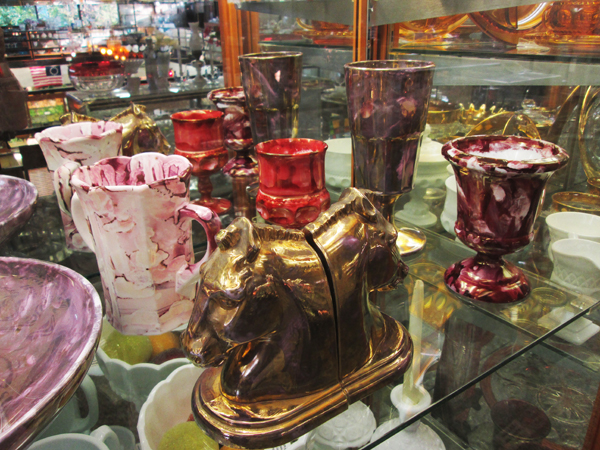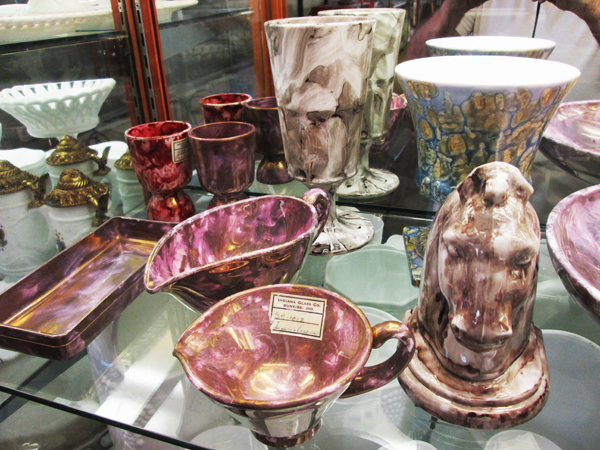| Company: |
Indiana Glass Company |
| Pattern Name: |
Kings Crown
Line #77
|
| Production Start Date: |
1959 |
| Production End Date: |
1971 |
Indiana Glass has a long history, and in some ways still exists as an active entity today. However, this
site is focused on this history of the Kings Crown pattern, which did not find its way into the Indiana Glass
catalog until relatively late in their timeline. I do not wish to trivialize their history and contributions
prior to or after their manufacturing of Kings Crown, but at the same time I need to stay on topic. Therefore,
although I provide a short timeline below, I do skip over much and I encourage you to follow the More Information links
to get a better idea of the company as a whole.
- In 1895, James Beaty and George Brady created the "Beaty and Brady Glass Company" in Dunkirk, IN.
- In 1899, National Glass Company of Pittsburgh, PA purchased Beaty and Brady Glass Company.
- In 1907, National Glass Company went into receivership due to a failed Pittsburgh bank.
- In 1908, a former employee named Frank Merry raised the capital needed to purchase the Dunkirk, IN factory and its assets. Once purchased, he formed the Indiana Glass Company.
- In 1953, the company merged with Lancaster Lens Company and created the Lancaster Glass Corporation.
- In 1961, a merger produced the Lancaster Colony Corporation, and Indiana Glass became a subsidiary of that corporation (I'm unclear of where they were headquartered, they would eventually be in Columbus, OH).
- In 2002, Lancaster Colony Corporation ended all glass making operations for Indiana Glass in Dunkirk, IN. Glass making operations were moved to Sapulpa, OK (company: Bartlett and Collins) and continues producing glass using the Indiana Glass name.
In 1959, the United States Glass Company (U.S. Glass Co.) was in decline and struggling to keep one of their
best-selling patterns (Dubonnet / Kings Crown / Old Thumbprint / #4016 / Antique Thumbprint) alive. Internal
memos between the Officers claimed that Indiana Glass had "copied" and "pirated"
their Kings Crown pattern. It wouldn't matter too much as U.S. Glass Co. would discontinue their Kings Crown
pattern in 1962, and close forever in 1963.
Be the claims of theft true or not, 1959 did see the start of Indiana Glass' "Line 77" /
"Kings Crown" release.
Sources (see the "Stories" section below) tell us that Indiana Glass had formally
purchased some moulds from U.S. Glass. Co. by 1962.
Indiana Glass' pieces may have had the general look of the U.S. Glass Co. pieces, but there were significant
differences, such as:
- Reduced catalog. U.S. Glass Co. had close to 80 pieces in this pattern, Indiana Glass reduced that significantly, with the bulk of the reduction being in removing compotes, serving bowls, and decorative items (bud vases, ash trays, etc), and concentrated on drinkware, plateware, and other table-focused items.
- New moulds reduced most of the stem seam counts from 3 to 2 and most of the press-piece seam counts from 4 to 3 (not a hard and fast rule, but generally true), reduced the thumbprint counts on some drinkware, and did away with any star/ray in the center of the piece.
- Red-based stain colors had a slightly more purple tint, and a plethora of new solid colors were introduced along with a silver paint line.
Sources (see the "Stories" section below) tell us that by 1962, Indiana Glass had converted
many of the moulds used to produce Kings Crown pieces from hand-press to machine-press, primarily for tableware
pieces such as plates, sugar, creamer, ice tea., etc. Those that are 2 seam were from the machine-press moulds,
and those with 3 from the hand-press ones. When looking at the pieces produced by Indiana Glass, you will
notice that the thumbprint is deeper on those that were hand-pressed. The deeper thumbprint caused issues with
the machine-pressed moulds in that the glass would not release, thus they were shallower.
Quick disclaimer: Much of this is conjecture based on what
I know/understand of the company's timeline, marketing material I can find, physical examples of shipping
materials, conversations with past Indiana Glass employees, and inspection of the pieces during the two eras.
Indiana Glass had started production of their Kings Crown line when they were part of the Lancaster Glass
Corporation. This continued when the 1961 merger made them a subsidiary of Lancaster Colony Corporation
("Colony"). It appears that they were allowed to develop and manufacture the line
independently until around 1970 when Colony found itself with a huge sales force, a rapidly growing demand for
their product, as well as new product launches such "Tiara Exclusives", and machine-made milk
glass.
It is around this time that we start to see a shift in the product line, with further reduction in the pieces
produced, a reduction in the color/stains produced, and a shift in the packaging to reflect
"Colony" instead of "Indiana Glass". Most notably was the ruby stain, which
looked very different from the prior ruby color, and had the consistency across pieces that only a machine can
accomplish. That color also accompanied a rebranding of the line to "Colony Crown", and for
the red, "Ruby Crown". Pieces also had a much more consistent and uniform rim, suggesting that
automation also managed the production of that section instead of humans.
It is because of the manufacturing, coloring, and branding changes that I differentiate between the Indiana
Glass and Colony releases, placing an end to the Indiana Glass production of Kings Crown circa 1971.
There is evidence, however, that some pieces which otherwise did not fit the Colony full-color lines or their
Ruby Crown line, may have continued on as Indiana Glass-branded pieces, such as the wedding bowls. Whenever
possible, we attempt to retain those under the Indiana Glass catalog and not the Colony catalog.
In the 1960s, Indiana Glass produced pieces in ruby stain and solid green for L.G. Wright Co.
It is unclear when this started, when it ended, or the catalog of pieces they produced for them.
With the closure of the Dunkirk facility in 2002, the building was torn down, and with it, all records of the
history, life, involved equipment, and the moulds themselves used for the production of the Kings Crown pattern
were completely lost.
In our Indiana Glass photo catalog, we feature a few goblets in a "marbled" milk glass.
Shortly after our posting of the orange/yellow images, the curator of the Glass Museum in Dunkirk, IN, Bob
Rawlings, reached out to provide information about the piece. Mr. Rawlings shared that he worked for the
Indiana Glass, Dunkirk factory for 30 years starting in 1962 in quality control, and at one point also
serving as the plant manager. He was in charge of quality control when the piece was first produced. The
decorating supervisor who created the piece was named Bob Rutherford, and the pattern was a prototype/sample
that never reached the production due to the cost to make. The line was called "Grecian", and
an example of the "Red Grecian" line is on display at the Glass Museum in Dunkirk.



Mr. Rawlings recounted an incident that occurred when he first started working at the plant, being in charge
of quality control. His first assignment was to re-sort a shipment of the ruby banded Kings Crown pieces that
had been returned to them by Montgomery Ward due to imperfections in the paint. That period of time had been
Indiana Glass' first attempt to paint the rim automatically instead of by hand. Soon after that incident, they
worked out the automation issues, and all subsequent ruby and cranberry tableware were painted via automation.
The gold and platinum pieces, however, were always painted by hand.
Mr. Rawlings recalled that Indiana Glass produced pieces in a blue stain in the late 1970, but that they were
not a very big seller.
With the closure of the Dunkirk factory, the Glass Museum in Dunkirk, IN was donated over 300 boxes of glass
pieces, each box containing around 10 to 12 items. As of 2015, Mr. Rawlings has only managed the time consuming
process of opening, identifying, and cataloging 162 of those boxes.
Mr. Rawlings is a wealth of information, and I encourage anyone with Indiana Glass questions to reach out to
him at the Museum (the provided link does have contact information on their page) with questions.